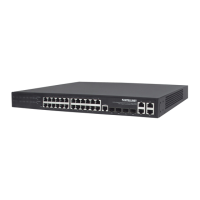b. Tagged VLAN packets arriving at the access port are dropped by the switch.
c. As far as the switch is concerned, any port that isn’t dened as a trunk or hybrid port is considered
an access port.
2. Trunk Ports (tagged)
a. Trunk ports are designed to lter out packets that have either no VLAN tag or VLAN tags that are
not on the allowed VLAN ID list.
b. Trunk ports do not remove any existing VLAN tags from incoming packets.
c. Trunk ports do not add a VLAN tag to any incoming untagged packet.
d. Trunk ports are ideal for switch-to-switch connections or for devices that have the ability to tag
packets by themselves such as VoIP phones.
3. Hybrid Ports
a. These are a combination of access and trunk ports.
b. Hybrid ports will tag any incoming packet that has no VLAN ID with the VLAN ID the port has been
assigned to.
c. Hybrid ports will also act as trunk ports for packets that have a VLAN tag.
NEW VLAN
Item Description
VLAN ID Type in the ID for the new VLAN. This value cannot be “1” nor any ID already
setup on the switch.
VLAN Name Provide a descriptive name for the VLAN (e.g., “VOICE”).
Choose to join the VLAN port Select all the ports you wish to be a part of this VLAN. Note that these ports
will act as access ports. They will add the VLAN ID to any untagged packet
and reject any incoming packets that have a VLAN tag.
Note: VLAN ID 1 is the default VLAN, which cannot be removed. However, access ports that are assigned to
another VLAN will be automatically removed from VLAN 1. The screen shot below shows what the setup
looks like after the above VLAN has been added:
TRUNK PORT SETTINGS
A trunk port transmits tagged packets and is used to connect dierent switches with one another.

